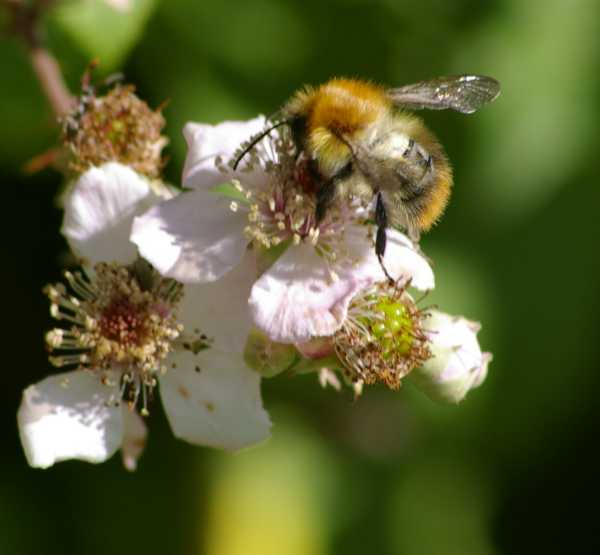Are Bees Smart?
Are bees smart? Do they have a memory? Can they solve problems, and be trained to understand concepts such as ‘different' or 'same’.
Most research in this area has investigated this question in studies involving honey bees. So what were their conclusions?
The short answer to this question is:
Yes, and in fact despite the tiny size of the honey bee brain at 1.9mg1, many scientific experiments have proven that honey bees can be taught to remember, recognize, discriminate and learn.
Are Bees Smart?
6 Science-based
Examples Which Prove They Are!
 The head of the Western honey bee (Apis mellifera) contains a powerful brain for its size!
The head of the Western honey bee (Apis mellifera) contains a powerful brain for its size!1. Honey bees can navigate their way through mazes!
That’s right! Scientists initially found
that they could teach bees to work their way through a maze using a color
coding system. However, they then found
the bees can learn to navigate their way out of a maze, even without the
assistance of a color code2.
In setting up this research, the scientists investigated the ability of honey bees to learn mazes of four types:
- constant-turn mazes (the correct turn is always in the same direction in each decision chamber);
- zig-zag mazes, in which the correct turn is alternately left then right in successive decision chambers;
- irregular mazes, in which there is no readily apparent pattern to the turns; and
- variable irregular mazes, in which the bees were trained to learn several irregular mazes simultaneously.
It was found that regularity in the structure of the maze aided recognition and learning in honey bees.
However, whilst performance was best in the constant-turn mazes (having higher regularity of structure), somewhat poorer in the zig-zag mazes, poorer still in the irregular mazes, and poorest in the variable irregular mazes, nevertheless, the bees were ultimately able to learn to navigate all four types of maze3.
2. Color recognition and reward
Bees have the ability to learn and also to be trained to
respond to rewards, such that bees can learn to associate rewards with a stimulus, such as colour.
This was proven in 1914 by Karl von Frisch4 who demonstrated that honey bees, not only see colors, they can learn to
simultaneously associate a reward with that color.
3. Bomb detection
I have written about this subject elsewhere, so I won’t expand
too much here, but it is known that honey bees can be trained to detect bombs.
4. Illness detection
In a similar way, experiments have proven that bees can be trained to associate
smells with illness such as cancer.
5. Bees understand concepts like ‘same’ and ‘different’, and ‘above' and 'below’
Scientists proved that honey bees can be trained to select a stimulus based on
whether it was the same or different to the test sample, in order to gain a
reward.
In other words, it didn’t matter
whether bees were required to choose a different stimulus, or the same one as the
sample, bees could be trained to do either.
Similarly, honey bees could distinguish between ‘above’ and ‘below’ and could
be trained to select one or the other, based on a learned association with a
reward5.
6. Bees have a good memory, and can remember and recognize
different human faces!
Scientists have found that honey
bees, with their tiny brains not only recognize different human faces, even
distinguishing one particular face from another, they can even remember the
same face for at least 2 days6!
References
1. Sayol, Ferran et al. (2020), Data from: Feeding specialisation and longer generation time are associated with relatively larger brains in bees, Dryad, Dataset, https://doi.org/10.5061/dryad.3xsj3txd9
2. Zhang SW, Bartsch K, Srinivasan MV. Maze learning by honeybees. Neurobiol Learn Mem. 1996 Nov; 66(3):267-82.
3. Zhang S, Mizutani A, Srinivasan MV. Maze navigation by honeybees: learning path regularity. Learn Mem. 2000;7(6):363-374. doi:10.1101/lm.32900
4. von Frisch, K. (1914). Der Farbensinn und Formensinn der Biene, Zoologische Jahrbücher. Abteilung für allgemeine Zoologie und Physiologie der Tiere. Champaign, IL: University of Illinois Urbana-Champaign.
5. Avarguès-Weber Aurore, Giurfa Martin 2013. Conceptual learning by miniature brains. Proc. R. Soc. B.280. 2013. 190720131907.
6. Dyer AG, Neumeyer C, Chittka L. Honeybee (Apis mellifera) vision can discriminate between and recognise images of human faces. J Exp Biol. 2005 Dec;208(Pt 24):4709-14. doi: 10.1242/jeb.01929. PMID: 16326952.


